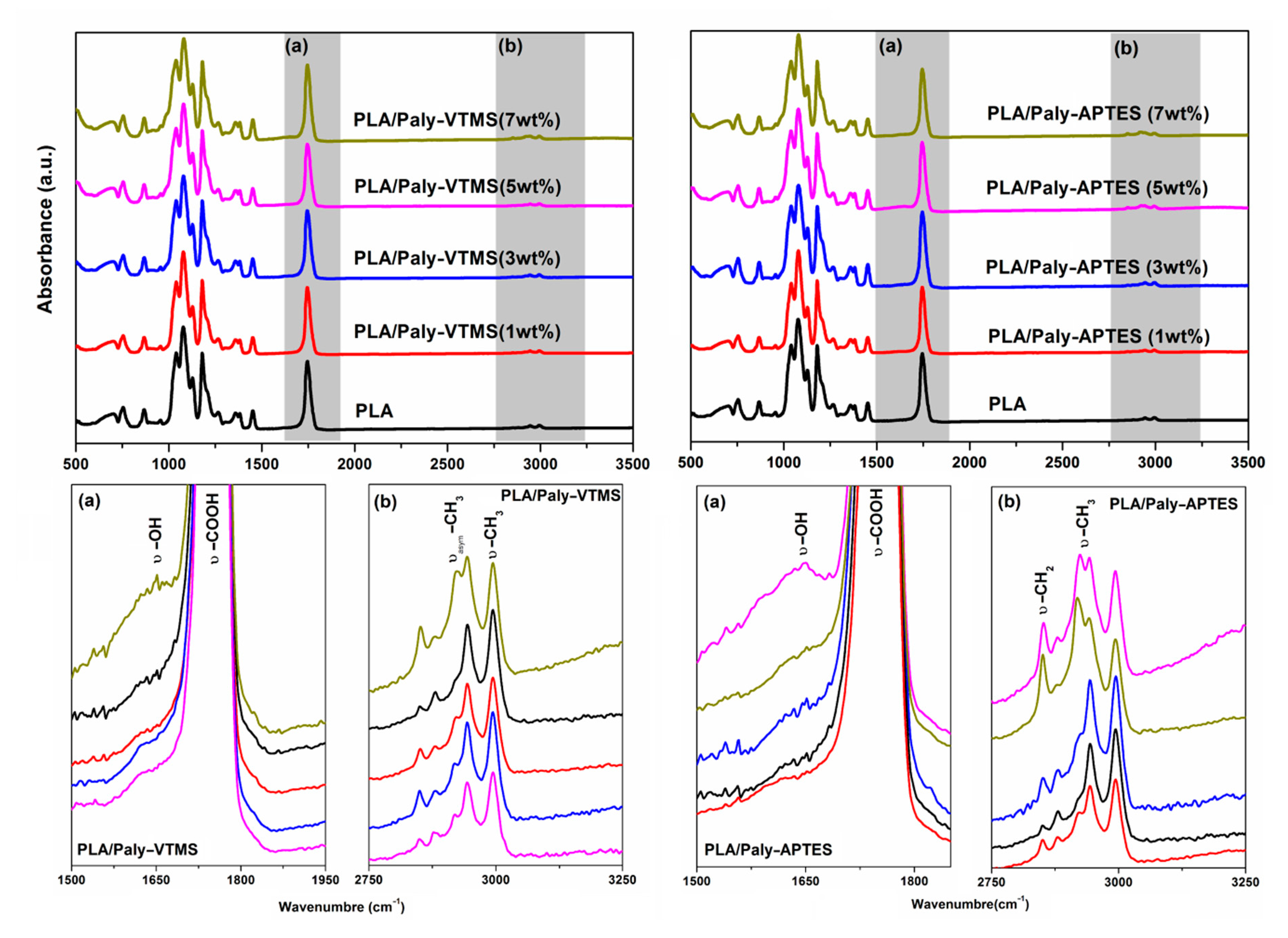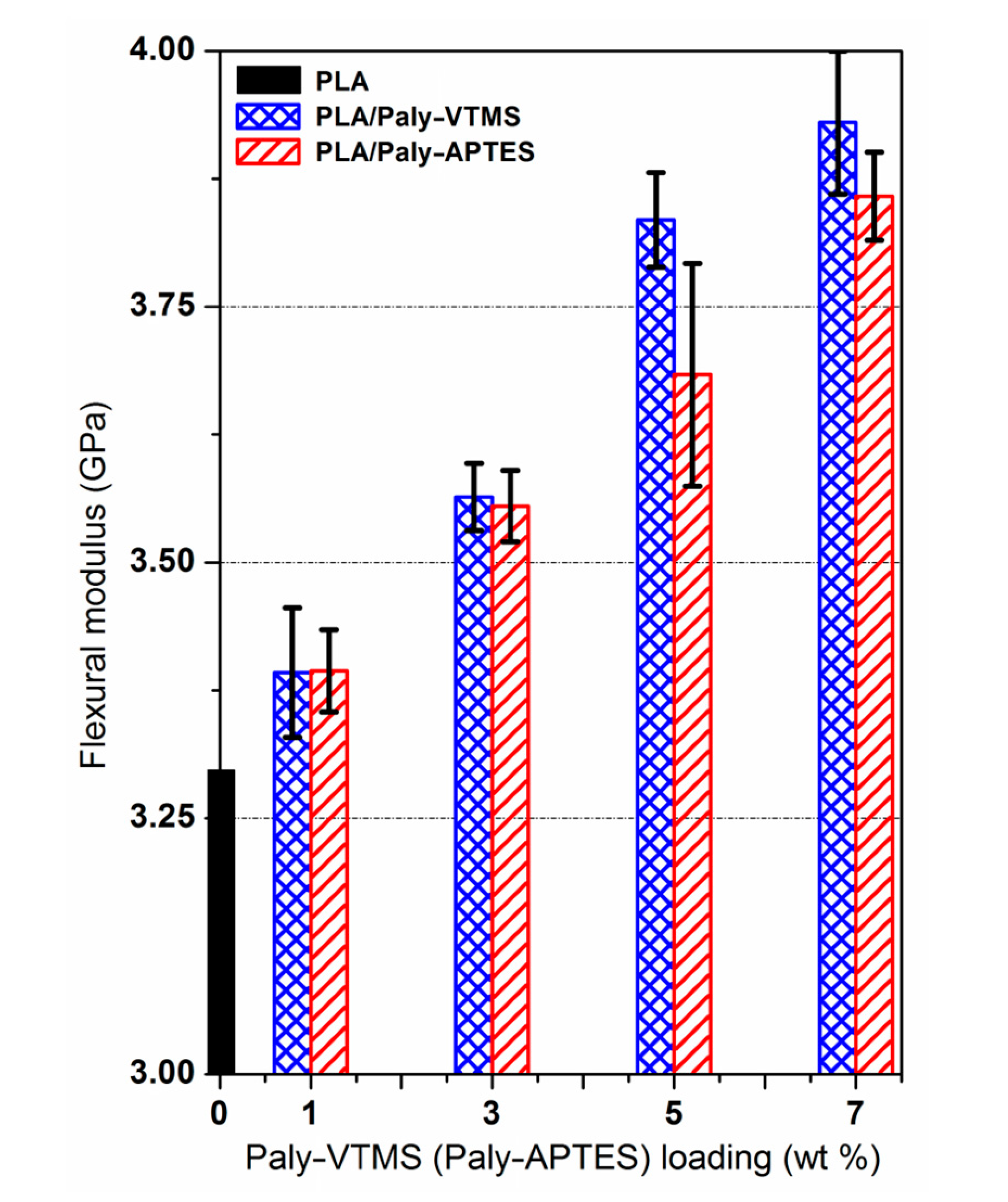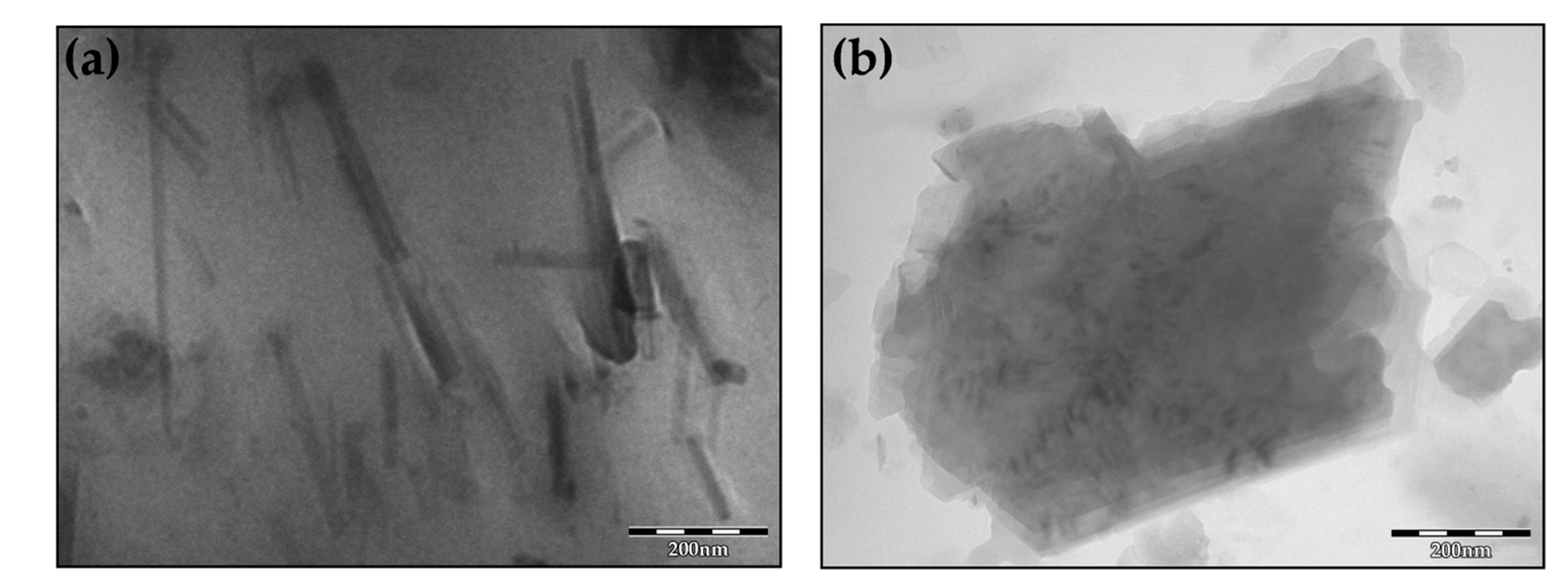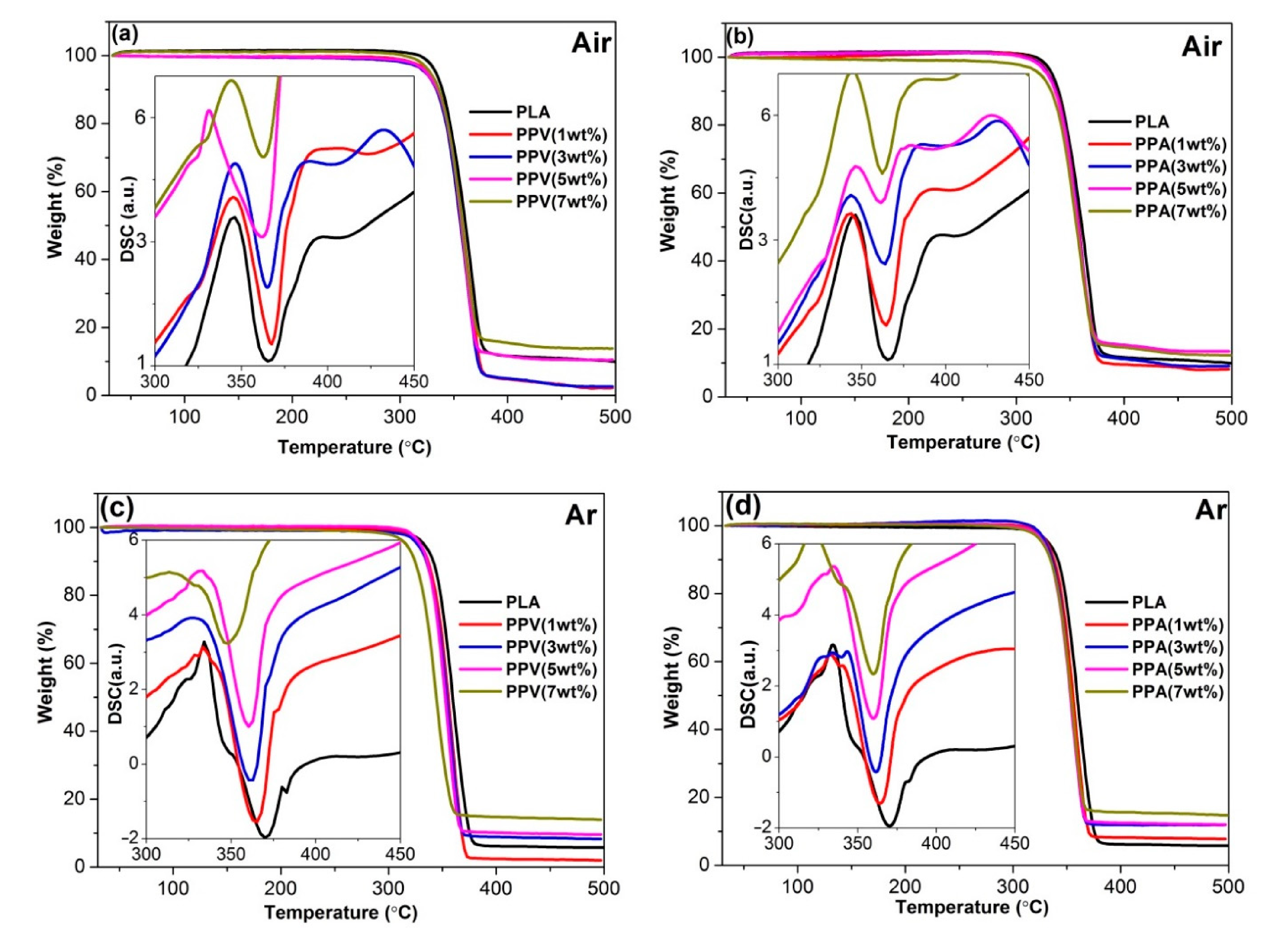Effect of Silane Functionalization on Properties of Poly(Lactic Acid)/Palygorskite Nanocomposites
Abstract
:1. Introduction
2. Material and Methods
2.1. Materials
2.2. Modification of Palygorskite
2.3. Preparation of Poly(Lactic Acid)/Palygorskite Nanocomposites
2.4. Characterization Methods
3. Results and Discussion
3.1. FTIR Analysis
3.2. Mechanical Properties
3.3. Morphology Analysis
3.4. Thermogravimetric Analysis
3.5. Differential Scanning Calorimetry
4. Conclusions
Author Contributions
Funding
Institutional Review Board Statement
Informed Consent Statement
Data Availability Statement
Acknowledgments
Conflicts of Interest
References
- Pandey, J.K.; Reddy, K.R.; Kumar, A.P.; Singh, R.P. An overview on the degradability of polymer nanocomposites. Polym. Degrad. Stab. 2005, 88, 234–250. [Google Scholar] [CrossRef]
- Lim, L.-T.; Auras, R.; Rubino, M. Processing technologies for poly(lactic acid). Prog. Polym. Sci. 2008, 33, 820–852. [Google Scholar] [CrossRef]
- Auras, R.; Harte, B.; Selke, S. An Overview of Polylactides as Packaging Materials. Macromol. Biosci. 2004, 4, 835–864. [Google Scholar] [CrossRef] [PubMed]
- Piemonte, V.; Sabatini, S.; Gironi, F. Chemical recycling of PLA: A great opportunity towards the sustainable development? J. Polym. Environ. 2013, 21, 640–647. [Google Scholar] [CrossRef]
- Plichta, A.; Lisowska, P.; Kundys, A.; Zychewicz, A.; Debowski, M.; Florjanczyk, Z. Chemical recycling of poly(lactic acid) via controlled degradation with protic (macro) molecules. Polym. Degrad. Stab. 2014, 208, 288–296. [Google Scholar] [CrossRef]
- Dorgan, J.R.; Lehermeier, H.J.; Palade, L.I.; Cicero, J. Poly lactides: Properties and prospects of an environmentally benign plastic from renewable resources. Macromol. Symp. 2001, 175, 55–66. [Google Scholar] [CrossRef]
- Pantani, R.; Sorrentino, A. Influence of crystallinity on the biodegradation rate of injection-moulded poly(lactic acid) samples in controlled composting conditions. Polym. Degrad. Stab. 2013, 98, 1089–1096. [Google Scholar] [CrossRef]
- Gorrasi, G.; Pantani, R. Effect of PLA grades and morphologies on hydrolytic degradation at composting temperature: Assessment of structural modification and kinetic parameters. Polym. Degrad. Stab. 2013, 98, 1006–1014. [Google Scholar] [CrossRef]
- Garlotta, D. A Literature Review of Poly(Lactic Acid). J. Polym. Environ. 2011, 9, 63–84. [Google Scholar] [CrossRef]
- Nel, A.; Xia, T.; Mädler, L.; Li, N. Toxic potential of materials. Science 2007, 311, 622–627. [Google Scholar] [CrossRef] [Green Version]
- Raquez, J.-M.; Habibi, Y.; Murariu, M.; Dubois, P. Polylactide (PLA)-based nanocomposites. Prog. Polym. Sci. 2013, 38, 1504–1542. [Google Scholar] [CrossRef]
- Rasal, R.M.; Janorkar, A.V.; Hirt, D.E. Poly(lactic acid) modifications. Prog. Polym. Sci. 2010, 35, 338–356. [Google Scholar] [CrossRef]
- Anderson, K.S.; Schreck, K.M.; Hillmyer, M.A. Toughening polylactide. Polym. Rev. 2008, 48, 85–108. [Google Scholar] [CrossRef]
- Liu, H.; Zhang, J. Research progress in toughening modification of poly(lactic acide). J. Polym. Sci. Part B Polym. Phys. 2011, 49, 1051–1083. [Google Scholar] [CrossRef]
- Fortunati, E.; Armentano, I.; Iannoni, A.; Barbale, M.; Zaccheo, S.; Scavone, M.; Visai, L.; Kenny, J.M. New multifunctional poly(lactide acid) composites: Mechanical, antibacterial, and degradation properties. J. Appl. Polym. Sci. 2012, 124, 87–98. [Google Scholar] [CrossRef]
- Rosli, N.A.; Ahmad, I.; Anuar, F.H.; Abdullah, I. Mechanical and thermal properties of natural rubber-modified poly(lactic acid) compatibilized with telechelic liquid natural rubber. Polym. Test. 2016, 54, 196–202. [Google Scholar] [CrossRef]
- Rasal, R.M.; Hirt, D.E. Toughness decrease of PLA–PHBHHx blend films upon surface-confined photopolymerization. J. Biomed. Mater. Res. Part A 2008, 88A, 1079–1086. [Google Scholar] [CrossRef] [PubMed]
- Hiljanen-Vainio, M.; Varpomaa, P.; Seppala, J.; Tormala, P. Modification of poly(l-lactides) by blending: Mechanical and hydrolytic behavior. Macromol. Chem. Phys. 1997, 197, 1503–1523. [Google Scholar] [CrossRef]
- Grijpma, D.W.; Nijenhuis, A.J.; Van Wijk, P.G.T.; Pennings, A.J. High impact strength as-polymerized PLLA. Polym. Bull. 1992, 29, 571–578. [Google Scholar] [CrossRef]
- Kruglikov, A.; Vasilchenko, A.; Kasprzhitskii, A.; Lazorenko, G. Atomic-level understanding of interface interactions in a halloysite nanotubes-PLA nanocomposite. RSC Adv. 2019, 9, 39505–39514. [Google Scholar] [CrossRef] [Green Version]
- Bordes, P.; Pollet, E.; Avérous, L. Nano-biocomposites: Biodegradable polyester/nanoclay systems. Prog. Polym. Sci. 2009, 34, 125–155. [Google Scholar] [CrossRef]
- Ray, S.S.; Okamoto, M. Polymer/layered silicate nanocomposites: A review from preparation to processing. Prog. Polym. Sci. 2003, 28, 1539–1641. [Google Scholar] [CrossRef]
- Paul, M.A.; Alexandre, M.; Degèe, P.; Henrist, C.; Rulmont, A.; Dubois, P. New Nanocomposite Materials Based on Plasticized Poly(l-Lactide) and Organo-Modified Montmorillonites: Thermal and Morphological Study. Polymer 2003, 44, 443. [Google Scholar] [CrossRef]
- Lazorenko, G.; Kasprzhitskii, A.; Yavna, V. Synthesis and structural characterization of betaine- and imidazoline-based organoclays. Chem. Phys. Lett. 2018, 692, 264–270. [Google Scholar] [CrossRef]
- Alexandre, M.; Dubois, P. Polymer-layered silicate nanocomposites: Preparation, properties and uses of a new class of materials. Mater. Sci. Eng. R Rep. 2000, 28, 1–63. [Google Scholar] [CrossRef]
- Lazorenko, G.; Kasprzhitskii, A.; Yavna, V. Comparative study of the hydrophobicity of organo-montmorillonite modified with cationic, amphoteric and nonionic surfactants. Minerals 2020, 10, 732. [Google Scholar] [CrossRef]
- Suárez, M.; García-Romero, E. Advances in the crystal chemistry of sepiolite and palygorskite. Elsevier Developm. Clay Sci. 2011, 3, 33–65. [Google Scholar] [CrossRef]
- Yin, H.; Chen, H.; Chen, D. Viscoelastic behavior of poly(acrylonitrile)/attapulgite nanocomposite solution. Colloids Surf. A Physicochem. Eng. Asp. 2010, 367, 52. [Google Scholar] [CrossRef]
- Sun, L.; Yang, Z.; Li, X. Effects of the treatment of attapulgite and filler contents on tensile properties of PTFE and attapulgite reinforced fabric composites. Compos. A 2009, 40, 1785. [Google Scholar] [CrossRef]
- Shen, L.; Lin, Y.; Du, Q.; Zhong, W. Studies on structure-property relationship of polyamide-6/attapulgite nanocomposites. Compos. Sci. Technol. 2006, 66, 2242. [Google Scholar] [CrossRef]
- Peng, L.; Zhou, L.; Li, Y.; Pan, F.; Zhang, S. Synthesis and properties of waterborne polyurethane/attapulgite nanocomposites. Compos. Sci. Technol. 2011, 71, 1280. [Google Scholar] [CrossRef]
- Hu, F.; Li, T.; Zhong, F.; Wen, S.; Zheng, G.; Gong, C.; Qin, C.; Liu, H. Preparation and properties of chitosan/acidified attapulgite composite proton exchange membranes for fuel cell applications. J. Appl. Polym. Sci. 2020, 137, 49079. [Google Scholar] [CrossRef]
- Bujdák, J.; Danko, M.; Chorvát, D.; Czímerová, A.; Sýkora, J.; Lang, K. Selective modification of layered silicate nanoparticle edges with fluorophores. Appl. Clay Sci. 2012, 65–66, 152–157. [Google Scholar] [CrossRef]
- Piscitelli, F.; Posocco, P.; Toth, R.; Fermeglia, M.; Pricl, S.; Mensitieri, G.; Lavorgna, M. Sodium montmorillonite silylation: Unexpected effect of the aminosilane chain length. J. Colloid Interface Sci. 2010, 351, 108–115. [Google Scholar] [CrossRef] [PubMed]
- Silva, A.A.; Dahmouche, K.; Soares, B.G. Nanostructure and dynamic mechanical properties of silane-functionalized montmorillonite/epoxy nanocomposites. Appl. Clay Sci. 2011, 54, 151–158. [Google Scholar] [CrossRef]
- Ianchis, R.; Corobea, M.C.; Donescu, D. Advanced functionalization of organoclay nanoparticles by silylation and their polystyrene nanocomposites obtained by miniemulsion polymerization. J. Nanopart. Res. 2012, 14, 1233. [Google Scholar] [CrossRef]
- Maisanaba, S.; Ortuño, N.; Jordá-Beneyto, M.; Aucejo, S.; Jos, A. Development, characterization and cytotoxicity of novel silane-modified clay minerals and nanocomposites intended for food packaging. Appl. Clay Sci. 2017, 138, 40–47. [Google Scholar] [CrossRef]
- Fan, Q.H.; Shao, D.D.; Hu, J.; Wu, W.S.; Wang, X.K. Comparison of Ni2+ sorption to bare and ACT-graft attapulgites: Effect of pH, temperature and foreign ions. Surf. Sci. 2008, 602, 778–785. [Google Scholar] [CrossRef]
- Raji, M.; Mekhzoum, M.E.M.; Rodrigue, D.; Qaiss, A.E.K.; Bouhfid, R. Effect of silane functionalization on properties of polypropylene/clay nanocomposites. Compos. B Eng. 2018, 146, 106–115. [Google Scholar] [CrossRef]
- Mishra, A.K.; Allauddin, S.; Narayan, R.; Aminabhavi, T.M.; Raju, K.V.S.N. Characterization of surface-modified montmoril-lonite nanocomposites. Ceram. Int. 2012, 38, 929–934. [Google Scholar] [CrossRef]
- Cai, Y.; Xue, J.; Polya, D.A. A Fourier transform infrared spectroscopic study of Mg-rich, Mg-poor and acid leached palygorskites. Spectrochim. Acta Part A Mol. Biomol. Spectrosc. 2007, 66, 282–288. [Google Scholar] [CrossRef] [PubMed]
- Helmy, A.K.; de Bussetti, S.G.; Ferreiro, E.A. The surface energy of palygorskite. Powder Technol. 2007, 171, 126–131. [Google Scholar] [CrossRef]
- Posthumus, W.; Magusin, P.C.M.M.; Brokken-Zijp, J.C.M.; Tinnemans, A.H.A.; van der Linde, R. Surface modification of oxidic nanoparticles using 3-methacryloxypropyltrimethoxysilane. J. Colloid Interface Sci. 2004, 269, 109–116. [Google Scholar] [CrossRef] [PubMed]
- Yan, W.; Yuan, P.; Chen, M.; Wang, L.; Liu, D. Infrared spectroscopic evidence of a direct addition reaction between palygorskite and pyromellitic dianhydride. Appl. Surf. Sci. 2013, 265, 585–590. [Google Scholar] [CrossRef]
- De Faria, E.H.; Ciuffi, K.J.; Nassar, E.J.; Vicente, M.; Trujillano, R.; Calefi, P.S. Novel reactive amino-compound: Tris(hydroxymethyl)aminomethane covalently grafted on kaolinite. Appl. Clay Sci. 2010, 48, 516–521. [Google Scholar] [CrossRef]
- Xue, A.; Zhou, S.; Zhao, Y.; Lu, X.; Han, P. Effective NH2-grafting on attapulgite surfaces for adsorption of reactive dyes. J. Hazard. Mater. 2011, 194, 7–14. [Google Scholar] [CrossRef]
- Laaziz, S.A.; Raji, M.; Hilali, E.; Essabir, H.; Rodrigue, D.; Bouhfid, R.; el kacem Qaiss, A. Bio-composites based on polylactic acid and argan nut shell: Production and properties. Int. J Biol. Macromol. 2017, 104, 30–42. [Google Scholar] [CrossRef]
- Marini, M.; Pourabbas, B.; Pilati, F.; Fabbri, P. Functionally modified core-shell silica nanoparyicles by one-pot synthesis. Colloids Surf. A 2008, 317, 473–481. [Google Scholar] [CrossRef]
- Wang, L.H.; Sheng, J. Controlled/«Living» radical polymerization. Halogen atom transfer radical polymerization promoted by a Cu(I)/Cu(II) redox process. J. Macromol. Sci. Part A Pure Appl. Chem. 2003, 40, 1135–1146. [Google Scholar] [CrossRef]
- Olejniczak, Z.; Łe˛czka, M.; Cholewa-Kowalska, K.; Wojtach, K.; Rokita, M.; Mozgawa, W. 29Si MAS NMR and FTIR study of inorganic-organic hybrid gels. J. Mol. Struct. 2005, 744, 465–471. [Google Scholar] [CrossRef]
- Wu, Z.; Ahn, I.-S.; Lee, C.-H.; Kim, J.-H.; Shul, Y.G.; Lee, K. Enhancing the organic dye adsorption on porous xerogels. Colloids Surf. A 2004, 240, 157–164. [Google Scholar] [CrossRef]
- Kuznetsova, A.; Wovchko, E.A.; Yates, J.T. FTIR study of the adsorption and thermal behavior of vinyltriethoxysilane chemisorbed on γ-Al2O3. Langmuir 1997, 13, 5322–5328. [Google Scholar] [CrossRef]
- Chieng, B.W.; Ibrahim, N.A.; Wan Yunus, W.M.Z.; Hussein, M.Z. Effects of graphene nanopletelets on poly(lactic acid)/poly(ethylene glycol) polymer nanocomposites. Adv. Mater. Res. 2014, 1024, 136–139. [Google Scholar] [CrossRef]
- Fortunati, E.; Luzi, F.; Puglia, D.; Dominici, F.; Santulli, C.; Kenny, J.M.; Torre, L. Investigation of thermo-mechanical, chemical and degradative properties of PLA-limonene films reinforced with cellulose nanocrystals extracted from Phormium tenax leaves. Eur. Polym. J. 2014, 56, 77–91. [Google Scholar] [CrossRef]
- Armentano, I.; Bitinis, N.; Fortunati, E.; Mattioli, S.; Rescignano, N.; Verdejo, R.; Lopez-Manchado, M.A.; Kenny, J.M. Multifunctional nanostructured PLA materials for packaging and tissue engineering. Prog. Polym. Sci. 2013, 38, 1720–1747. [Google Scholar] [CrossRef] [Green Version]
- Lai, S.-M.; Wu, S.-H.; Lin, G.-G.; Don, T.-M. Unusual mechanical properties of melt-blended poly(lactic acid) (PLA)/clay nanocomposites. Eur. Polym. J. 2014, 52, 193–206. [Google Scholar] [CrossRef]
- Fukushima, K.; Tabuani, D.; Camino, G. Poly(lactic acid)/clay nanocomposites: Effect of nature and content of clay on morphology, thermal and thermo-mechanical properties. Mater. Sci. Eng. C 2012, 32, 1790–1795. [Google Scholar] [CrossRef]
- Gomez-Gamez, A.B.; Yebra-Rodriguez, A.; Peñas-Sanjuan, A.; Soriano-Cuadrado, B.; Jimenez-Millan, J. Influence of clay percentage on the technical properties of montmorillonite/polylactic acid nanocomposites. Appl. Clay Sci. 2020, 198, 105818. [Google Scholar] [CrossRef]






| Label | Chemical Name | Structural Formula | Molecular Weight (g/mol) |
|---|---|---|---|
| PLA | Polylactide Ingeo 4032D |  | 123,000.00 |
| APTES | 3-Aminopropyltriethoxysilane |  | 221.37 |
| VTMS | Vinyltrimethoxysilane |  | 148.23 |
| Sample | Glass Transition Temperature, Tg (°C) | Melting Temperature, Tm (°C) | Crystallinity Index, Xc (%) | Weight Loss (%) |
|---|---|---|---|---|
| PLA | 59 | 170 | 0.9 | 94.2 |
| PPV (1 wt%) | 59 | 170 | 17.6 | 98.0 |
| PPV (3 wt%) | 60 | 170 | 34.0 | 91.7 |
| PPV (5 wt%) | 60 | 170 | 41.2 | 90.4 |
| PPV (7 wt%) | 61 | 163 | 11.4 | 86.1 |
| PPA (1 wt%) | 59 | 170 | 15.6 | 92.2 |
| PPA (3 wt%) | 57 | 168 | 29.1 | 88.1 |
| PPA (5 wt%) | 58 | 168 | 42.4 | 88.0 |
| PPA (7 wt%) | 61 | 164 | 23.5 | 85.2 |
Publisher’s Note: MDPI stays neutral with regard to jurisdictional claims in published maps and institutional affiliations. |
© 2021 by the authors. Licensee MDPI, Basel, Switzerland. This article is an open access article distributed under the terms and conditions of the Creative Commons Attribution (CC BY) license (http://creativecommons.org/licenses/by/4.0/).
Share and Cite
Kasprzhitskii, A.; Lazorenko, G.; Kruglikov, A.; Kuchkina, I.; Gorodov, V. Effect of Silane Functionalization on Properties of Poly(Lactic Acid)/Palygorskite Nanocomposites. Inorganics 2021, 9, 3. https://0-doi-org.brum.beds.ac.uk/10.3390/inorganics9010003
Kasprzhitskii A, Lazorenko G, Kruglikov A, Kuchkina I, Gorodov V. Effect of Silane Functionalization on Properties of Poly(Lactic Acid)/Palygorskite Nanocomposites. Inorganics. 2021; 9(1):3. https://0-doi-org.brum.beds.ac.uk/10.3390/inorganics9010003
Chicago/Turabian StyleKasprzhitskii, Anton, Georgy Lazorenko, Alexander Kruglikov, Irina Kuchkina, and Vadim Gorodov. 2021. "Effect of Silane Functionalization on Properties of Poly(Lactic Acid)/Palygorskite Nanocomposites" Inorganics 9, no. 1: 3. https://0-doi-org.brum.beds.ac.uk/10.3390/inorganics9010003





